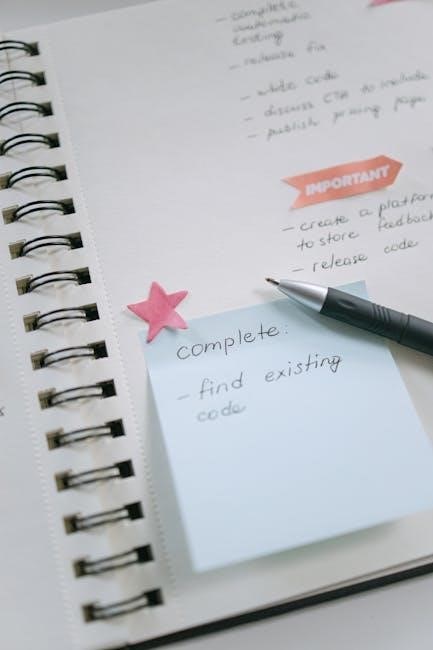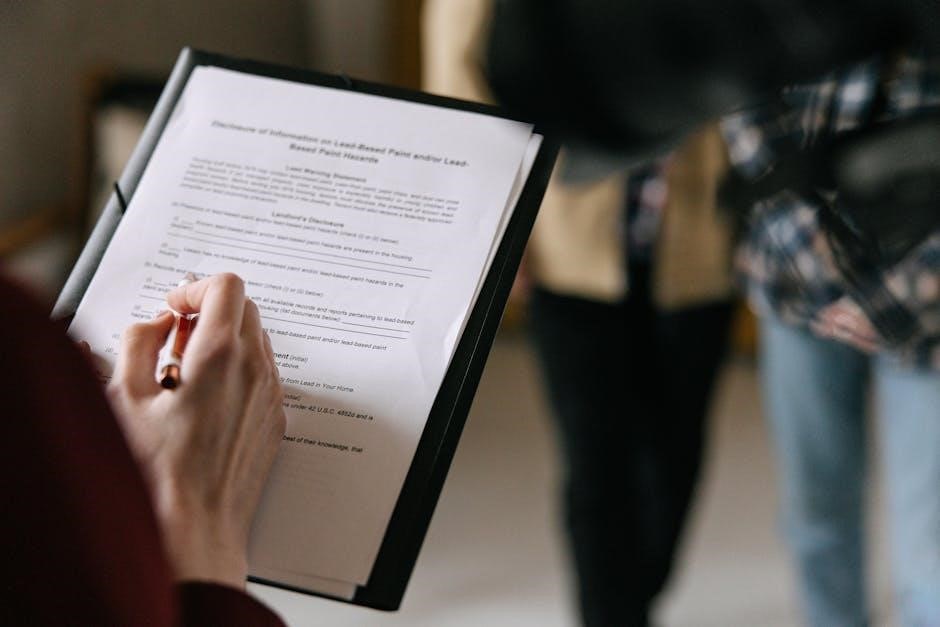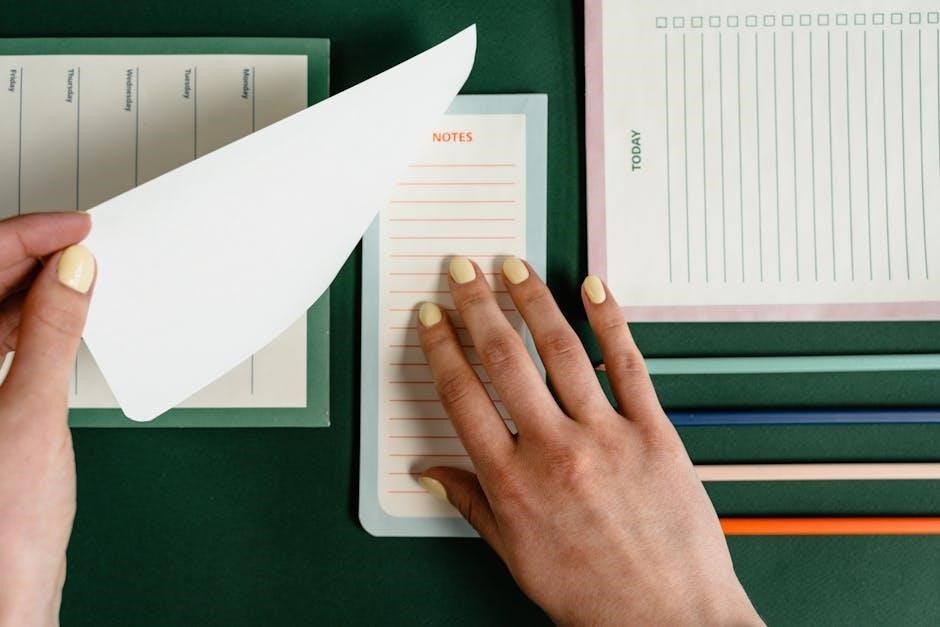A 6-month wedding checklist and timeline are essential tools for organizing tasks, ensuring every detail is addressed. This structured approach helps manage time, budget, and vendor bookings efficiently, reducing stress and ensuring a seamless celebration.
1.1 Importance of a 6-Month Wedding Checklist
A 6-month wedding checklist is crucial for ensuring a smooth and stress-free planning process. It helps couples stay organized, track deadlines, and prioritize tasks effectively. By breaking down the planning process into manageable steps, the checklist prevents oversights and ensures all details are addressed. It also aids in budget management, vendor coordination, and timelines, allowing couples to focus on enjoying the experience. A well-structured checklist provides clarity and reassurance, making it easier to handle last-minute adjustments. Ultimately, it serves as a roadmap, guiding couples through the final months leading up to their wedding day, ensuring everything is perfectly in place for a memorable celebration.
1.2 Benefits of Using a Wedding Planning Timeline
A wedding planning timeline offers numerous benefits, especially for couples planning a wedding in six months. It provides a clear, structured framework, ensuring all tasks are completed on time. By outlining key milestones and deadlines, it helps avoid last-minute chaos and ensures nothing is overlooked. The timeline also enhances communication with vendors and the wedding party, keeping everyone aligned. Additionally, it allows couples to allocate their time and resources efficiently, reducing stress and making the planning process more enjoyable. With a detailed timeline, couples can stay focused, achieve their vision, and transition smoothly into their special day with confidence and clarity.

Month 1-2: Initial Planning and Budgeting
Month 1-2 focuses on setting a realistic budget, creating a guest list, and selecting a venue. Hiring a planner can streamline the process and ensure timely progress.
2.1 Setting a Realistic Wedding Budget
Setting a realistic wedding budget is crucial for a stress-free planning experience. Start by determining how much you and your partner can afford, considering all income sources. Estimate costs for venue, catering, photography, attire, and decorations. Prioritize expenses based on what matters most to you both. Allocate funds to high-priority areas while cutting back on less important details. Consider creating a contingency fund for unexpected expenses. Regularly review and adjust the budget to ensure you stay on track. Using a budgeting app or spreadsheet can help monitor spending. A well-planned budget ensures your special day is both memorable and financially sustainable.
2.2 Creating a Guest List and Contact Information

Creating a detailed guest list is a foundational step in wedding planning. Begin by deciding on the number of attendees, considering venue capacity and budget constraints. Categorize guests into family, close friends, and acquaintances. Include full names, mailing addresses, phone numbers, and email addresses for invitations. Ensure accuracy to avoid errors. Share the list with vendors for seating, catering, and invitations. Regularly update the list as RSVPs are received. Organize contact information in a spreadsheet or digital tool for easy access. This step ensures smooth communication and helps track responses efficiently, making the planning process more manageable.

2.3 Researching and Booking a Wedding Venue
Researching and booking a wedding venue is a critical step in the planning process. Start by identifying venues that align with your vision, budget, and guest count. Compare amenities, availability, and reviews. Visit potential locations to assess layout, ambiance, and accessibility. Once satisfied, secure the venue by signing a contract and paying a deposit. Ensure the date and time are confirmed. Popular venues may have limited availability, so act promptly. Clearly understand the terms, including catering, decorations, and guest capacity; Booking early ensures your preferred date is reserved, allowing you to move forward with other planning tasks confidently. A venue sets the tone for your wedding, so choose wisely.
2.4 Hiring a Wedding Planner or Coordinator
Hiring a wedding planner or coordinator can significantly simplify the planning process. They bring expertise, connections, and organization to ensure every detail is executed flawlessly. Start by researching local planners, reviewing testimonials, and scheduling consultations. Discuss your vision, budget, and expectations to find the right fit. A planner can recommend reliable vendors, manage timelines, and handle logistics, reducing stress. If a full-service planner isn’t within your budget, consider hiring a day-of coordinator to oversee the event. Their involvement ensures a smooth and enjoyable experience, allowing you to focus on celebrating with loved ones. Investing in professional guidance can make a substantial difference in the overall success of your wedding.

Month 3: Vendor Selection and Bookings
Research and book vendors like photographers, videographers, caterers, florists, and entertainers. Compare portfolios, schedules, and prices to ensure availability and quality for your wedding date.
3.1 Choosing a Photographer and Videographer
Selecting the right photographer and videographer is crucial for capturing your wedding memories. Start by researching portfolios to ensure their style matches your vision. Check availability for your wedding date and read reviews to assess reliability. Discuss your budget and expectations during consultations. Ensure they understand your preferences for posed shots, candid moments, and lighting. Consider hiring a second shooter for comprehensive coverage. Compare packages and negotiate details like delivery timelines and rights to the photos. Booking early ensures you secure top choices, as popular vendors fill up quickly. A professional team will help create timeless memories of your special day.
3.2 Selecting a Catering Service
Choosing the right catering service is vital for a memorable wedding experience. Start by researching reputable vendors, reading reviews, and asking for referrals. Schedule tastings to evaluate food quality and presentation. Discuss your budget, dietary restrictions, and preferences to customize the menu. Ensure the caterer can accommodate your guest count and venue requirements. Review their experience with events of your size and style. Check if they provide servers, utensils, and tableware. Compare pricing structures and negotiate the contract details. Finalize the menu and service timeline to ensure seamless execution on your wedding day. A reliable caterer will enhance your celebration with delicious food and exceptional service.
3.3 Booking a Florist andDecorator
3.3 Booking a Florist and Decorator
Booking a florist and decorator is a key step in creating the visual atmosphere of your wedding. Begin by researching local vendors, reviewing portfolios, and gathering recommendations. Schedule consultations to discuss your theme, color scheme, and budget. Share inspiration images to ensure alignment with your vision. Inquire about their experience with events of your size and style. Confirm availability for your date and venue. Discuss flower availability, seasonal options, and backup plans for unexpected shortages. Ensure they provide setup and teardown services. Review and finalize the contract, including all details like centerpiece designs, bouquet styles, and decor placement. A skilled florist and decorator will bring your wedding aesthetics to life, enhancing the overall experience for you and your guests.
3.4 Hiring Entertainment (Band/DJ)
Hiring entertainment, such as a band or DJ, is crucial for setting the tone and keeping guests engaged; Start by researching local options, reading reviews, and requesting referrals. Watch videos or attend live performances to assess their style and energy. Discuss your playlist preferences, ensuring they align with your wedding vibe. Inquire about equipment, backups, and overtime policies. Compare pricing and services, then book early to secure your choice. Ensure the contract includes setup time, song requests, and any special dedications. A professional entertainer will elevate your celebration, creating unforgettable moments for you and your guests.

Month 4: Wedding Attire and Party Planning
Focus on selecting and ordering the wedding dress, choosing attire for the groom and attendants, and finalizing the wedding party roles and responsibilities.
4.1 Selecting and Ordering the Wedding Dress
Dedicate time to finding the perfect wedding dress by setting a budget and deciding on a style that suits your theme and body type. Research designers and boutiques, schedule fittings, and allow ample time for alterations. Ensure the dress is ordered early to avoid delays, and consider accessories like veils or jewelry to complete the look. Proper planning ensures a stunning and stress-free experience for the bride-to-be.
4.2 Choosing Attire for Groom, Bridesmaids, and Groomsmen
Coordinate outfits for the wedding party by setting a budget and style that aligns with the wedding theme. For the groom, choose a suit or tuxedo that fits well, considering fabric and color. Bridesmaids should select dresses that complement the bride’s gown, ensuring sizes and alterations are handled promptly. Groomsmen attire should match the groom’s style for a cohesive look. Schedule fittings and finalize orders early to avoid delays. Ensure accessories like ties, shoes, and jewelry are consistent across the party. Proper planning ensures everyone looks polished and ready for the big day, reflecting the wedding’s overall aesthetic seamlessly.

4.3 Finalizing the Wedding Party and Roles
Decide on the size and composition of your wedding party, selecting a Maid of Honor, Best Man, bridesmaids, and groomsmen. Ensure each member understands their responsibilities, such as planning pre-wedding events or assisting on the day. Discuss attire expectations and budget to avoid confusion. Schedule dress and suit fittings for the party, ensuring all alterations are completed well in advance. Assign specific roles, like speech delivery or coordination tasks, to keep everything organized. Finally, plan activities like bachelor or bachelorette parties to celebrate and strengthen bonds before the wedding. Clear communication and delegation are key to a cohesive and stress-free wedding party experience.

Month 5: Finalizing Details
In Month 5, focus on finalizing the ceremony order, reception layout, and seating arrangements. Confirm RSVPs, send invitations, and schedule cake tastings. Ensure all details are finalized and vendors are confirmed to avoid last-minute issues.
5.1 Finalizing the Wedding Ceremony Order
Finalizing the wedding ceremony order involves creating a detailed timeline of events, from the processional to the recessional. Ensure all participants, including the officiant, readers, and musicians, are confirmed and aware of their roles. Review and finalize vows, readings, and music selections. Coordinate with vendors to confirm setup and timing. Conduct a rehearsal to ensure smooth execution. Make sure to address any last-minute changes and distribute the final order to all involved. This step is crucial for a seamless and meaningful ceremony that reflects your personal style and traditions.
5.2 Planning the Reception Layout and Seating
Planning the reception layout and seating involves creating a detailed floor plan to maximize space and ensure guest comfort. Decide on table arrangements, such as round or long tables, and assign seating based on relationships and preferences. Consider special requests, like wheelchair accessibility or VIP sections. Finalize the layout with your venue and vendors, ensuring adequate space for dancing, bars, and other activities. Create a seating chart to guide guests and share it with the venue staff. This step ensures a cohesive and organized setup, enhancing the overall guest experience and making the reception a coordinated and enjoyable experience for everyone.
5.3 Ordering Wedding Invitations and Stationery
Ordering wedding invitations and stationery is a crucial step in the planning process. Typically, invitations are sent 8-10 weeks before the wedding, so finalizing designs and wording by Month 5 is essential. Choose stationery that reflects your wedding theme and style. Include RSVP cards, accommodation cards, and directions if needed. Digital invitations are also an option for convenience. Ensure all details, such as date, time, location, and dress code, are clearly stated. Proofread for errors and confirm printing quality. Once ready, address and mail them promptly, adding a personal touch like a custom stamp. This step ensures guests are informed and excited for your special day.
5.4 Scheduling a Cake Tasting and Ordering
Scheduling a cake tasting is an exciting milestone in your wedding planning journey. Research local bakeries and schedule tastings with 2-3 top choices. During the tasting, discuss your wedding theme, color scheme, and dietary preferences to ensure the cake complements your celebration. Consider the number of guests, cake design, and flavor combinations. Finalize the order by Month 5 to secure your baker’s availability. Be sure to request a written contract outlining details like delivery, setup, and payment terms. A deposit is typically required to confirm the order. This step ensures your wedding cake is both visually stunning and delicious, making it a memorable part of your special day.

Month 6: Final Preparations
Confirm all vendor details, finalize the wedding timeline, coordinate rehearsals, and pack an emergency kit. Ensure everything is ready for the big day.
6.1 Confirming All Vendor Details
Confirming all vendor details is crucial in the final month. Ensure every vendor, including the venue, caterer, photographer, and florist, has the correct date, time, and setup instructions. Verify arrival times, delivery schedules, and equipment needs. Review contracts and confirm payment details. Make sure all vendors have a clear understanding of their roles and expectations. This step prevents last-minute misunderstandings and ensures a smooth execution of your wedding day. Clear communication and written confirmations are essential for peace of mind. Having everything finalized allows you to focus on enjoying the celebration with your partner, family, and friends.
6.2 Finalizing the Wedding Timeline
Finalizing the wedding timeline is a critical step in the last month of planning; Create a detailed schedule outlining every event, from vendor arrivals to the send-off. Confirm setup times, ceremony start, speeches, and reception activities. Share this timeline with your wedding party, family, and vendors to ensure everyone is aligned. Include buffer times for unexpected delays and review the flow to avoid overlaps. Distribute the final timeline digitally or in print for easy access. This step ensures a smooth, stress-free execution of your wedding day, allowing you to enjoy the celebration with confidence. A well-planned timeline is key to a seamless and memorable event.
6.3 Coordinating Rehearsals and Rehearsal Dinners
Coordinating rehearsals and rehearsal dinners is a vital part of the final preparations. Schedule a dress rehearsal a day before the wedding to practice the ceremony flow, ensuring everyone knows their roles and cues. Book a venue for the rehearsal dinner, typically hosted by the groom’s family, to celebrate with close friends and family. Send invitations and finalize the menu, keeping it simple yet meaningful. Use this time to relax and bond with loved ones before the big day. Ensure all participants are aware of the rehearsal schedule and dinner details. This step helps ease nerves and builds anticipation for the wedding celebration.
6.4 Packing an Emergency Wedding Day Kit
An emergency wedding day kit is a must-have for unexpected situations. Include essentials like safety pins, tissues, breath mints, and a mini sewing kit for wardrobe fixes. Add bobby pins, hair spray, and makeup touch-up items for quick beauty fixes. Pack pain relievers, band-aids, and antacids for personal needs. Bring a portable charger for devices and a small blanket for cold moments. Don’t forget a stain remover pen and wet wipes for spills. Store everything in a small, accessible bag and assign someone to handle it. This kit ensures you’re prepared for any last-minute hiccups, allowing you to stay calm and enjoy your special day worry-free.

Additional Tips for Stress-Free Planning
Prioritize tasks, stay organized, and delegate responsibilities to avoid overwhelm. Regularly review your checklist and maintain open communication with vendors and your partner to ensure a smooth process.
7.1 Managing Stress During the Planning Process
Managing stress during wedding planning requires a proactive approach. Start by breaking tasks into smaller, manageable steps to avoid feeling overwhelmed. Delegate responsibilities to trusted friends, family, or a wedding planner to share the workload. Regularly review your checklist to track progress and celebrate milestones. Schedule downtime and engage in relaxing activities to maintain mental and emotional balance. Open communication with your partner and vendors can help address concerns early, preventing last-minute issues. Remember, perfection is not the goal—focus on creating a meaningful and joyful celebration that reflects your love and commitment to each other.
7.2 Handling Last-Minute Changes or Issues
Last-minute changes or issues are inevitable, but staying calm and flexible is key. Identify the problem quickly and communicate clearly with vendors and your partner. Prioritize solutions over stress, focusing on what can be realistically resolved. Keep an emergency kit on hand for small fixes, like safety pins or tissues. If a vendor cancels, have a backup list ready. Weather concerns? Ensure a contingency plan, such as a tent or indoor space. Remember, guests often won’t notice minor hiccups. Trust your team and enjoy the moment—your wedding is about celebrating love, not perfection.
7.3 Enjoying the Journey and Celebrating Milestones
Planning a wedding in 6 months is a whirlwind, but it’s important to savor the journey. Celebrate milestones like booking the venue, finalizing attire, and completing major tasks. Schedule regular date nights or relaxation time to maintain balance. Share progress with loved ones to stay connected and excited. Reflect on why you’re marrying—this keeps perspective and joy alive. Remember, the journey is as meaningful as the wedding day itself. Embrace the process, cherish moments, and trust that your hard work will create unforgettable memories. Enjoying the experience ensures a happy and stress-free celebration.
With a detailed 6-month wedding checklist, couples can efficiently manage their planning journey. Stay organized, prioritize tasks, and enjoy the process. Your dedication ensures a memorable wedding day and a joyful future together.
8.1 Final Checklist Review
Conducting a thorough final checklist review ensures all tasks are completed. Verify venue bookings, vendor confirmations, and guest RSVPs. Review the wedding timeline, seating arrangements, and emergency kit essentials; Double-check payments and gratuities. Ensure attire fittings are done and accessories are ready. Review the wedding ceremony order and reception layout. Confirm rehearsal details and transportation. Lastly, pack essentials like tissues, mints, and bobby pins. This meticulous review guarantees everything is in place for a stress-free wedding day, allowing you to focus on celebrating with loved ones. A well-organized review process is key to a seamless and enjoyable celebration.
8.2 Preparing for the Big Day
As the wedding day approaches, focus on final preparations to ensure a smooth and enjoyable celebration. Conduct a final run-through of the wedding timeline with vendors and the wedding party. Confirm all vendor deliveries and setup times. Ensure your attire is ready, including accessories and footwear. Pack an overnight bag for the wedding night and prepare a day-of emergency kit. Attend the rehearsal to rehearse the ceremony and enjoy the rehearsal dinner with loved ones. On the eve of the wedding, rest and relax, trusting that all details are in place. This final preparation phase is about tying loose ends and embracing the excitement of your special day.
8.3 Enjoying the Wedding and Beyond
After months of meticulous planning, it’s time to cherish the moment and celebrate with loved ones. On the wedding day, focus on soaking in the joy, exchanging vows, and creating unforgettable memories. Capture every special moment through photos and videos to treasure forever. Post-wedding, share highlights with friends and family, and enjoy the honeymoon as a perfect getaway. Reflect on the journey and how it has strengthened your bond. Remember, the wedding is just the beginning—nurture the love and commitment that brought you to this day. Embrace the happiness and excitement as you embark on your new life together, carrying the magic of your wedding day forward.